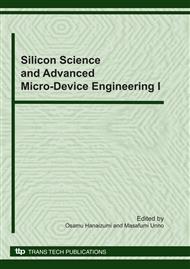p.145
p.153
p.157
p.162
p.168
p.173
p.179
p.183
p.190
Design and Fabrication of Novel Photonic Crystal Waveguide Consisting of Si-Ion Implanted SiO2 Layers
Abstract:
In this paper, we designed and fabricated two-dimensional photonic crystal (2-D PhC) consisting of the silicon ion (Si-ion) implanted silicon dioxide (SiO2) layers. The PhC design parameters based on the telecommunication wavelength (λ=1.55 µm) were obtained using finite-difference time-domain (FDTD) method. By analyzing the samples fabricated using different fabrication approach; we found a suitable fabrication method for 2-D PhCs based on the Si-ion implanted SiO2 layers. We have analyzed the fabricated sample using atomic force microscope (AFM) and annealing temperature and time were optimized in order to recover the damage done by Si-ion implantation. The implantation of Si-ion into SiO2 with the process of 2-D PhCs structure can effectively guide light inside such structure, which can easily be integrated into the existing silicon technology for directing light from one part of the chip to the other.
Info:
Periodical:
Pages:
168-172
Citation:
Online since:
December 2010
Price:
Сopyright:
© 2011 Trans Tech Publications Ltd. All Rights Reserved
Share:
Citation:


